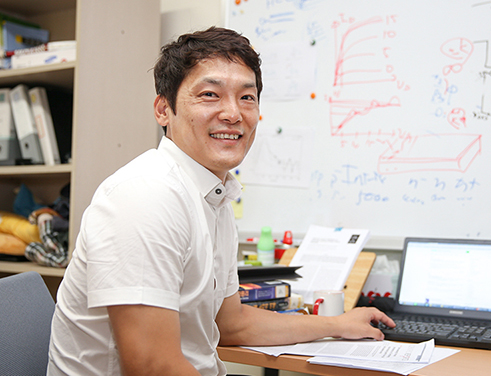"Blood Sugar Meter in a Smart Phone?” N
No.88789- Writer pr
- Date : 2015.07.07 10:41
- Views : 8006
Department of Physics Professor Shin Jae-cheol developed new ‘nanowire’ synthesis technology to produce short-wavelength infrared detection sensor
Core technologies needed to develop next-generation electric/electronic materials such as memory and sensors
Possible to integrate meters for sugar in fruits and blood-sugar, as well as night vision goggles
Published in latest issue of world’s most reputable academic journal <Scientific Report>
[Jun 19, 2015]

Department of Physics Professor Shin Jae-cheol (39, photo) developed new technologies to efficiently synthesize the promising next-generation technology of nanowire in silicone substrates and successfully produced a short-wavelength infrared detection sensor using this.
Nanowires are very fine fan-shaped wires with nanometer (nm, 1m/1 billion m) diameter and is receiving attention as core future technologies needed to develop advanced electric and electronic elements such as transistors, memory, and various sensors. Currently, semiconductor nanowires used metal nano-particles or nano-patterning technologies for synthesis. However, such methods have the weakness that they require high cost and time, and therefore have limitations in commercialization.
In 2013, Professor Shin Jae-cheol developed technologies to synthesize indium arsenide (InAs) on top of a 2 inch silicon substrate using a catalyst-free, pattern-free method, and in this study, these technologies were used to produce a short-wavelength infrared detection sensor with 1~3 micrometer (μm) wavelengths. Until now, chemical semiconductor substrates such as InAs and lead selenide were used to produce short-wavelength infrared detection sensors, but such material substrates have the weakness that they are dozens of times more expensive than silicone. But with this study, such problems were resolved. It is expected that silicon-based InAs nanowires produced with this technology can be applied not only in short-wavelength infrared detection sensors, but in other technological sectors such as solar cells, LED, lasers, and transistors.
Professor Shin, who participated in this study as a corresponding author, said, “Short-wavelengths of 1~3μm can penetrate into substances to some degree, so it can be used to check for irregularities in fruits, blood-sugar inspection, and skin disease examinations. Furthermore, it detects the reflections of infrared rays copied in the atmosphere so it can be used for night-vision goggles and for rescue cameras in the case of fires, thus having high usability.” He added, “By further developing the short-wavelength infrared photodetector through the silicon-based InAs nanowire synthesis developed in this study, it will be possible create a new market as fruit sugar meters, blood sugar meters, and night vision goggles that can be mounted on smart phones can be manufactured, which was not practice in the past due to cost issues, and it will thus lead the global market.”
Professor Shin earned his PhD at the University of Wisconsin-Madison and worked as a researcher at the Korea Photonics Technology Institute’s Biophotonic Research Center and has been serving as a professor at YU since September 2014. Professor Shin said, “My main field of study was photoelectronic elements such as solar cells, infrared red photodetectors, LED and lasers,” and added, “I will continue research on developing high-performance photoelectronic elements that are inexpensive through semiconductor nanostructures.”
Meanwhile, this study was published under the title ‘Short-wavelength infrared photodetector on Si employing strain-induced growth of very tall InAs nanowire arrays’ in the latest online version (June 2015) world-class academic journal in the top 7.3% of the relevant field, <Scientific Reports, impact factor (IF) 5.078>.